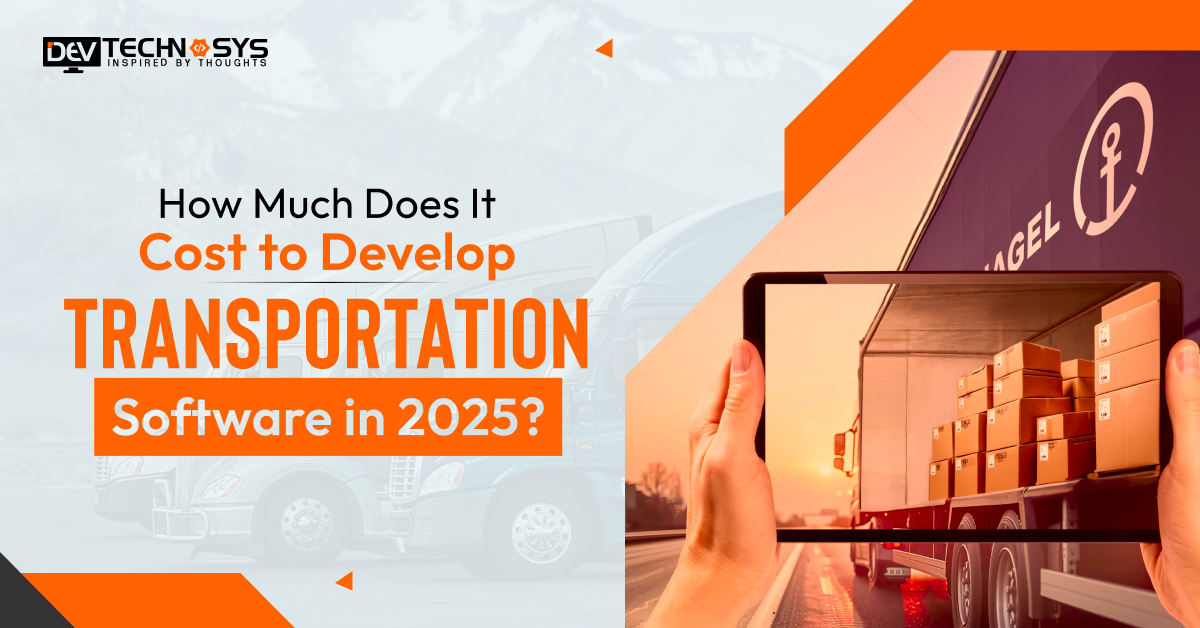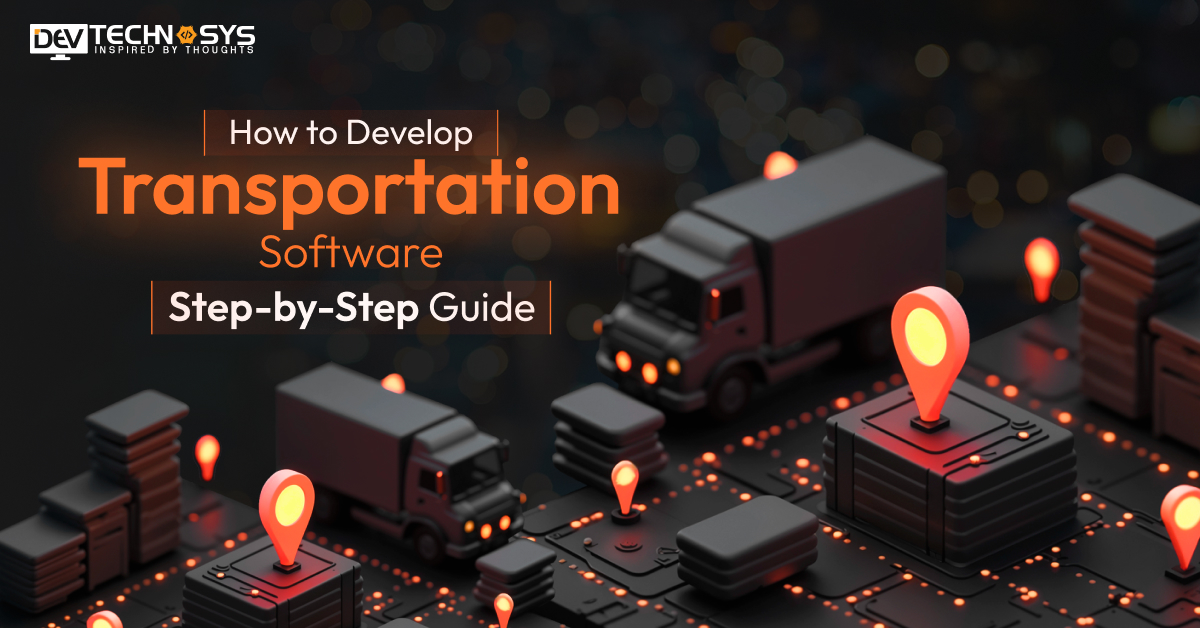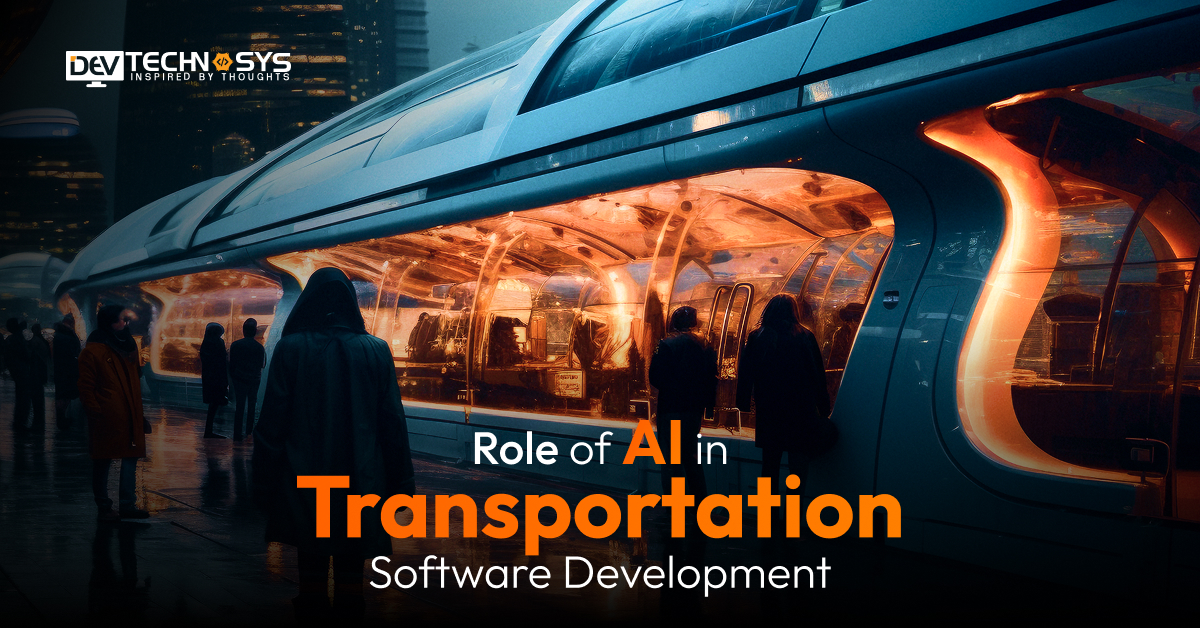The arrival of the Transport Management System (TMS) has completely changed the logistics industry, making transportation easier and efficient. According to Technavio’s report on the TMS market, the transportation management systems market size is forecast to increase by USD 4.74 billion at a CAGR of 11.7% between 2024 and 2029.
The transportation software market is witnessing significant growth, thanks to the rising demand, efficiency in transportation operations, and the reduction in costs in logistics and supply chain management.
This increasing market demand brings numerous opportunities for businesses to enter the lucrative transport industry with their own Transportation app. However, building a transport app isn’t an easy feat. Businesses often consider the cost of logistics software during the development.
Knowing the mobile transportation software development charges helps businesses prepare their budget accordingly. However, the transportation app cost estimation in UAE relies on several factors, such as features, complexity, and the development team.
In today’s guide, we will discuss the cost to develop transportation software, the features involved, the tech stack required, and more. Read the complete post to know the crucial components clearly and learn how transportation software development services can help you build a custom TMS tailored to your business needs.
What is TMS Software?
A transportation management system (TMS) is a subset of logistics platforms that help businesses plan, execute, and optimize the transportation of goods, both incoming and outgoing, by leveraging the latest technology. The on-demand transportation app also ensures that the shipment is compliant and has proper documentation.
Key Functions of TMS Software:
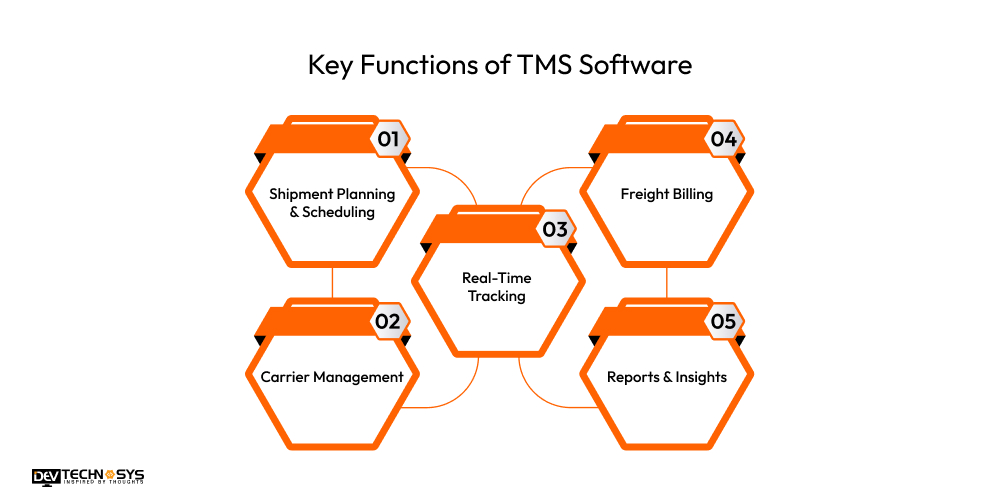
- Shipment Planning & Scheduling: Finds the fastest and most cost-effective delivery routes.
- Carrier Management: Selects the most suitable shipping partners based on rates and reliability.
- Real-Time Tracking: provides live updates on shipments for better visibility.
- Freight Billing: Automates payment and invoice checks.
- Reports & Insights: Shows data to improve delivery performance and reduce costs.
Qualities That Make up a Good Transportation Management System
According to a top iOS app development company, the cost of transportation management system development may vary. Obviously, it depends on features and functions it possesses and the ease of operation.
Here are the major qualities that define an effective TMS:
- Business Compatibility
- Multifunctionality
- Ease of Use
- Scalability
- Data Processing & Analytics
- Integration Capabilities
- Customization
- Cost Efficiency
An efficient TMS can make the transportation easier, whether you are a carrier, shipper, or a 3PL. Though only when it meets the demands of your business. Each system has its own features and differs from the others. Some of them are only aimed at a specific sector of economics.
So, the first and top quality that makes a TMS great is that it fits your business like a glove. The next thing that makes a transport management system effective is its multifunctional ability and diverse data processing capabilities.
Market Analysis of Transportation Management Systems Industry
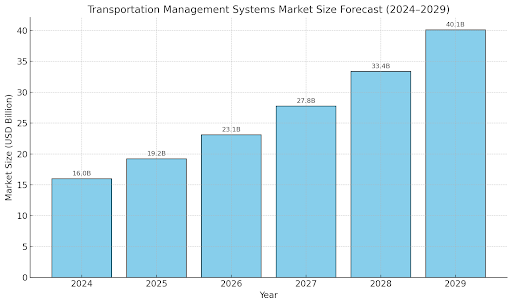
- The market size of transportation management systems is expected to grow from USD 16.0 billion in the year 2024 to USD 40.3 billion by 2029 at a CAGR of 20.2% in the forecast period.
- The transportation management system market size around the world was estimated to reach USD 15.88 billion in 2024 and it is expected to reach USD 41.57 billion by 2030, growing at a CAGR of 17.5% from 2025 to 2030.
- The United Arab Emirates Software market is expected to generate a revenue of US$2.02 billion by 2025.
- According to a latest survey, 80% of users focus on fundamental functions, such as route planning and shipment tracking, when adding TMS software solutions.
- The German market of transportation management systems is expected to rise at a notable CAGR from 2025 to 2030.
Top 10 Transportation Management Apps to Explore in 2025
Here are the top 10 transportation management apps that can make transportation easier and more efficient.
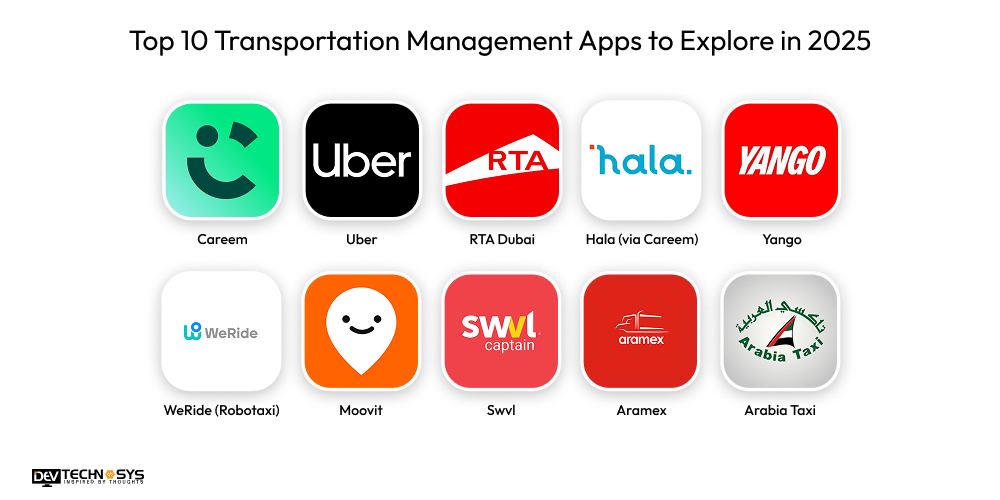
App |
Launch Year |
Ratings (iOS / Android) |
Platforms |
| Careem | 2012 | ★ 4.5 / ★ 4.2 | iOS, Android |
| Uber | 2009 | ★ 4.4 / ★ 4.2 | iOS, Android |
| RTA Dubai | 2013 | ★ 4.2 / ★ 4.0 | iOS, Android, Huawei |
| Hala (via Careem) | 2020 | ★ 4.4 / ★ 4.2 | iOS, Android |
| Yango | 2022 | ★ 4.0 / ★ 4.1 | iOS, Android |
| WeRide (Robotaxi) | 2023 | ★ 4.1 / ★ 4.0 | iOS, Android |
| Moovit | 2012 | ★ 4.3 / ★ 4.2 | iOS, Android |
| Swvl | 2017 | ★ 4.0 / ★ 4.1 | iOS, Android |
| Aramex Mobile App | 2020 | ★ 4.0 / ★ 4.0 | iOS, Android |
| Arabia Taxi | 2005 | ★ 3.8 / ★ 3.9 | iOS, Android |
What are the Benefits of Investing in Transportation Software for Businesses?
Before discussing the cost to develop transportation software, let’s discuss how businesses can benefit from transportation software:
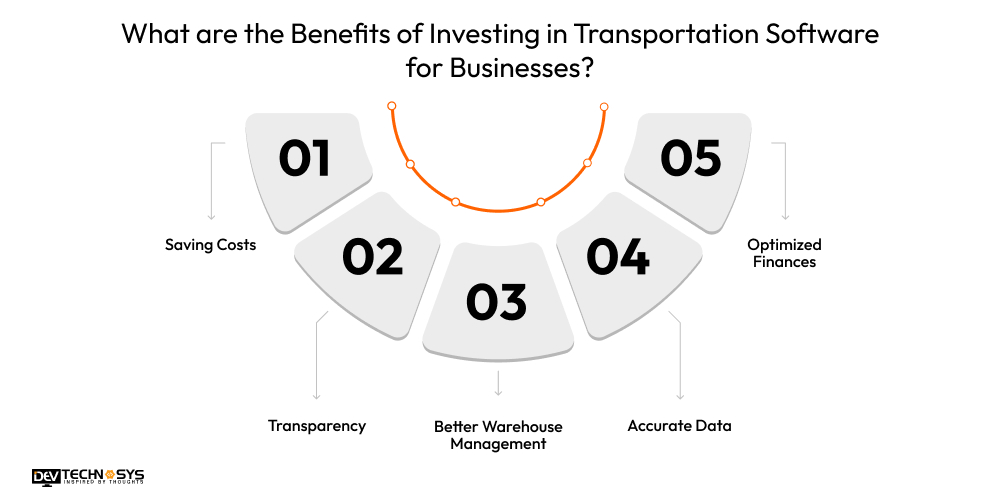
-
Saving Costs:
The high savings on cost to create a transportation management system are among the top benefits. Research proves that companies can save up to 8% by using the TMS application.
The reduction of cost to build transportation software can be attributed to overall supply chain optimization using AI technology, automated decision-making, route optimization, load consolidation, time savings, and reduced overcharges and audits.
-
Transparency
Creating transportation management software can help increase transparency, which is a major customer demand nowadays. Availability of all transportation-related data in one place allows for rescheduling and shipment tracking in real time, quick, efficiently, and with the least expected cost.
-
Better Warehouse Management
Planned load storage and shipment activities can drive warehouse management system updates. Logistics applications use advanced route planning algorithms for improving delivery times and saving costs in transportation.
-
Accurate Data
Another benefit to develop a transportation software is the increasing accuracy of data, which results in a cut in manual access and enhanced visibility.
-
Optimized Finances
Entrusting the billing and payments to the TMS system leads to an accurate decrease in charges, reducing them to a minimum, and quick detection and correction of duplicate payments. It all makes your financial monitoring simple and clear.
TMS Pricing Models and Cost Structures
Selecting an appropriate structure for on-demand transportation app development cost requires careful evaluation of available pricing options. There are various pricing models for transportation software development, different models provide specific advantages that match various organizational requirements and financial capabilities.
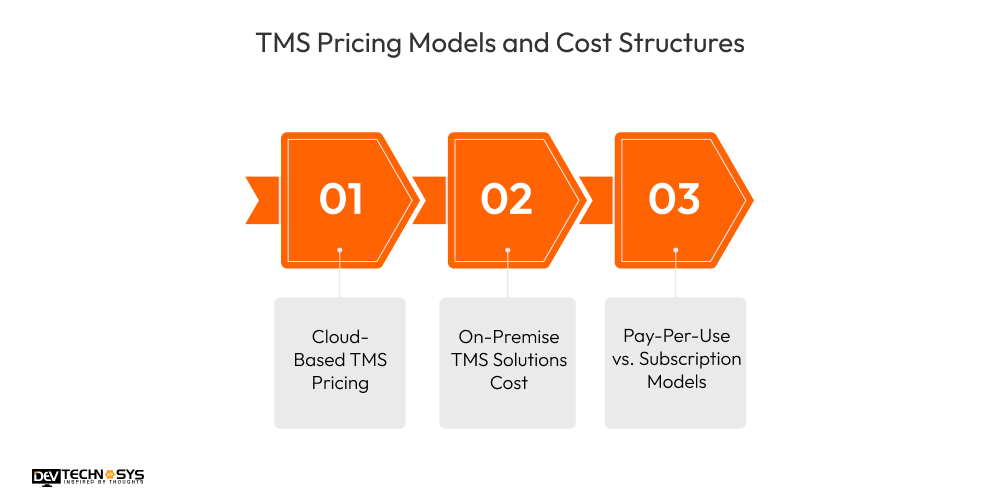
-
Cloud-Based TMS Pricing
Cloud-based TMS platforms operate on subscription pricing, with user fees ranging from $50 to $500 monthly. Recent industry research indicates significant savings on initial setup when compared to traditional installation methods. Standard subscriptions include regular system updates, security maintenance, and basic support services.
-
On-Premise TMS Solutions Cost
Traditional on-premise installations require larger upfront payments, starting at $75,000 for basic setups. These systems need dedicated hardware and regular maintenance investments. Organizations operating extensive transportation networks often prefer on-premise options because they allow complete control over system customization and data management.
-
Pay-Per-Use vs. Subscription Models
Pay-per-use structures calculate fees based on shipping quantities or specific function usage. Companies providing android App development services in UAE use this approach for businesses with variable transportation requirements or seasonal operations. Here’s a breakdown of available pricing structures:
TMS Pricing Structure Comparison
Pricing Model |
Best For |
Cost |
Benefit |
| Pay-Per-Use | Seasonal businesses | $2–$5 per shipment | No fixed cost, pay as needed |
| Monthly Subscription | Mid-sized companies | $200–$800/month | Full access, predictable pricing |
| Annual License | Large enterprises | $25,000–$100,000/year | Premium support, cost-efficient |
What is the Cost to Develop Transportation Software?
The cost to develop transportation software generally ranges between $8,000 to $25,000 or more, depending on the scope, features, and complexity of the system. The average cost to create a fleet management system with simple features and functionalities ranges from $8,000 to $15,000. If you want transportation software with advanced features like automated route optimization, real-time tracking, and ePOD, then the cost of development will be much higher.
Keep in mind that the cost to maintain an app is a separate, ongoing cost that covers bug fixes, system updates, security patches, and potential feature enhancements. The app maintenance cost is generally not included in the initial development package, so consult with your development partner beforehand if they charge additional cost for app maintenance.
The below table showcases the cost to make a logistics and transportation app and how each factor contributes to the overall price. If you want more accurate freight management software cost analysis, then consult the experts.
Type |
Cost (USD) |
Timeline |
| Basic System | $8K – $12K | 2 – 4 months |
| Mid-Level TMS | $12K – $18K | 4 – 6 months |
| Advanced Platform | $18K – $22K | 6 – 9 months |
| Enterprise Solution | $22K – $27K+ | 9 – 12+ months |
Features of Logistics Apps That May Impact Your Budget
Logistics apps help businesses in transportation management, keeping track of shipments, and increasing supply chain operation efficiency. However, adding specific features can increase the on-demand transportation app development cost. Here are some key features that may impact your budget:
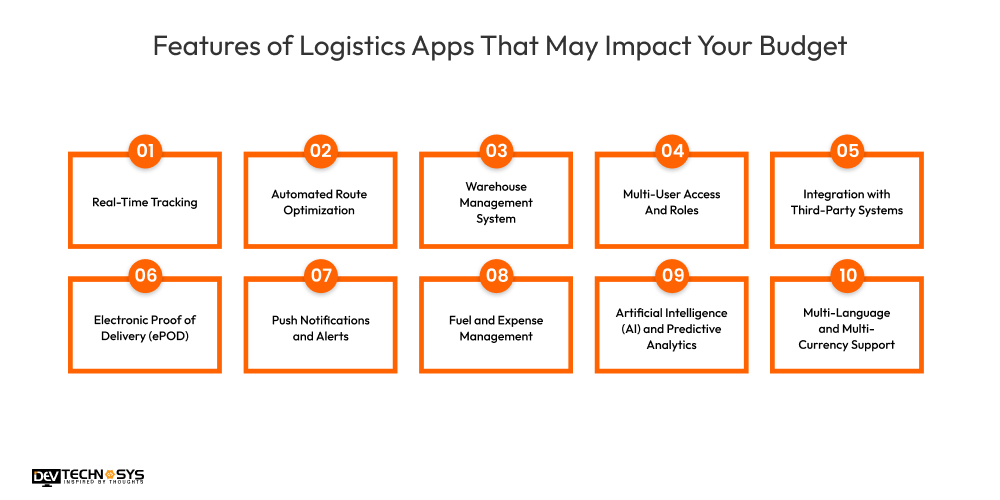
1. Real-Time Tracking
Real-time GPS tracking deals with shipments and vehicle tracking, making it easier for businesses to manage shipments. This feature requires integration with mapping services and cloud storage, increasing the cost to develop an app.
2. Automated Route Optimization
A transport application with route optimization recommends the best delivery routes, reducing fuel costs and delivery time. However, this feature includes complex algorithms, raising the development expenses.
3. Warehouse Management System
Adding a warehouse management module helps with inventory tracking, manage orders, and streamline operations. This feature requires a robust database and backend support, making it costly.
4. Multi-User Access and Roles
A logistics app should support different user roles, such as drivers, dispatchers, and managers. Setting up secure access and permissions for multiple users increases development complexity and costs.
5. Integration with Third-Party Systems
Many logistics apps integrate with ERP, CRM, and accounting software. These integrations enhance functionality but require additional development time and API costs.
6. Electronic Proof of Delivery (ePOD)
Drivers can capture digital signatures, upload photos, or scan QR codes as proof of delivery. Developing this feature involves mobile camera access, cloud storage, and security protocols, impacting the cost to develop transportation software.
7. Push Notifications and Alerts
Instant alerts for delivery updates, delays, or route changes improve efficiency. However, implementing push notifications with real-time data processing increases the development budget.
8. Fuel and Expense Management
A fuel tracking system helps businesses monitor fuel usage and expenses. This feature requires integration with vehicle tracking systems. The cost to develop transportation software can increase because of adding this feature.
9. Artificial Intelligence (AI) and Predictive Analytics
AI-driven analytics help businesses predict demand, optimize inventory, and reduce costs. However, artificial intelligence implementation requires data collection, machine learning algorithms, and extra development time.
10. Multi-Language and Multi-Currency Support
It is important to add multi-language and currency support while making a logistics app for international users. This feature can increase development and testing time, leading to higher costs.
Factors Affecting The Cost of Logistics App Development
The cost to develop a logistics mobile app varies based on several factors. Understanding these cost influencing factors can help you plan your budget more accurately.
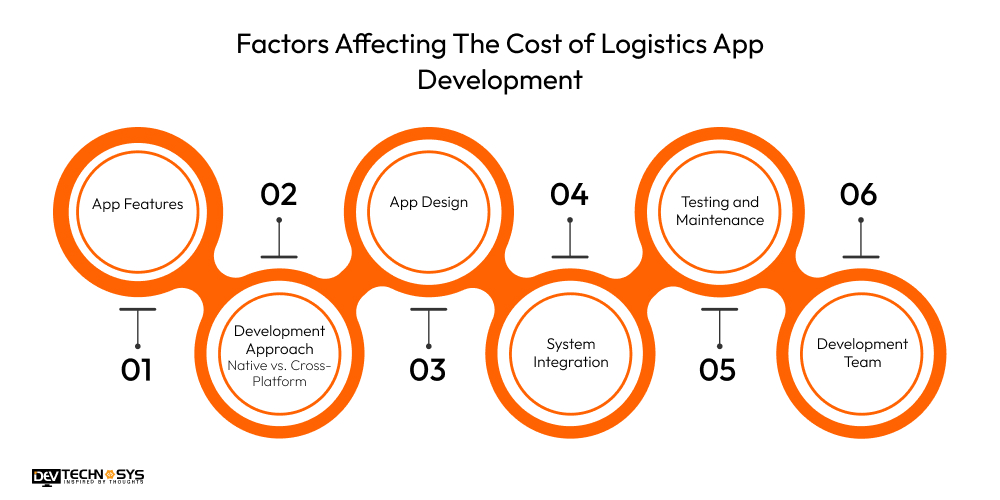
1. App Features
With the number of features, the cost to build transformation software will also increase. Complex features require more time and resources, increasing expenses.
For example, Basic features like freight tracking and supply chain visualization can cost between $10,000 and $15,000.
Features similar to Uber Freight’s on-demand delivery service require real-time updates and a strong backend, adding to the transportation software development pricing.
Adding more features increases the overall development budget. Consult with the professionals who can provide a more accurate analysis of freight management software cost to gain insight into cost-impacting factors.
Feature Set |
Estimated Cost (USD) |
Development Time |
| Basic (tracking, login, order management) | $8,000 – $12,000 | 2 – 3 months |
| Advanced (real-time tracking, route optimization, analytics) | $13,000 – $20,000 | 3 – 5 months |
| Premium (multi-language, AI routing, live chat, etc.) | $20,000 – $25,000 | 4 – 6 months |
2. Development Approach: Native vs. Cross-Platform
The choice between native and cross-platform MVP development also affects costs. Native apps are made particularly for iOS or Android using platform-specific languages. Since they require separate codebases, they are more expensive.
Cross-platform apps work on numerous platforms with a single codebase. They are more affordable but may compromise performance.
Approach |
Estimated Cost (USD) |
Development Time |
| Native (iOS + Android separately) | $18,000 – $25,000 | 4 – 6 months |
| Cross-Platform (Flutter, React Native) | $10,000 – $16,000 | 3 – 4 months |
3. App Design
A logistics app typically features three user interfaces: one for dispatchers, one for drivers, and another for administrators. Designing these interfaces requires extensive research, prototyping, and app testing.
A simple UI/UX design costs less, while a complex, visually appealing design increases expenses.
The more effort required to create an intuitive design, the higher the development cost.
Design Complexity |
Estimated Cost (USD) |
Development Time |
| Basic UI/UX | $1,500 – $3,000 | 2 – 3 weeks |
| Custom Interactive Design | $3,000 – $6,000 | 1 – 1.5 months |
4. System Integration
If your app that provides transportation app cost estimation in UAE needs to connect with external systems like payment gateways, CRM, ERP, payroll, or billing software, the cost will rise. This system integration expense is generally included in the initial custom transportation software pricing packages.
Companies seeking artificial Intelligence development services should be aware that each system integration may cost between $3,000 and $15,000, depending on its complexity.
Integration Scope |
Estimated Cost (USD) |
Development Time |
| Basic APIs (maps, SMS, notifications) | $2,000 – $4,000 | 2 – 3 weeks |
| Advanced Systems (CRM, ERP, GPS, payment gateway) | $5,000 – $7,000 | 1 – 1.5 months |
5. Testing and Maintenance
According to a top transportation software development company in Saudi Arabia, testing ensures the app runs smoothly without errors. After launch, regular maintenance keeps it compatible with new OS updates and technology changes, adding to long-term costs.
Service Scope |
Estimated Cost (USD) |
Development Time |
| Basic Testing Only | $1,000 – $2,000 | 2 – 3 weeks |
| Full QA + 3–6 Months Maintenance | $3,000 – $5,000 | Ongoing |
6. Development Team
The cost to hire developers for transportation software depends on their skills, location, and experience. Highly skilled developers charge more but deliver better quality apps. The table below outlines the cost to hire developers for transportation software, depending on team type. Take a look:
Team Type |
Estimated Cost (USD) |
Development Time |
| Freelancers/Small Agency | $8,000 – $12,000 | 3 – 4 months |
| Mid-Size Company | $13,000 – $18,000 | 3 – 5 months |
| Enterprise-Level Partner | $18,000 – $25,000 | 4 – 6 months |
How to Save Money on Logistics App Development
According to top developers who provide transportation software development services, there are various ways to save money on logistics app development. The best ways to save money on logistics apps are defining precise requirements, using cross-platform development, starting with an MVP, hiring offshore teams, and more. Let’s learn about them in detail:
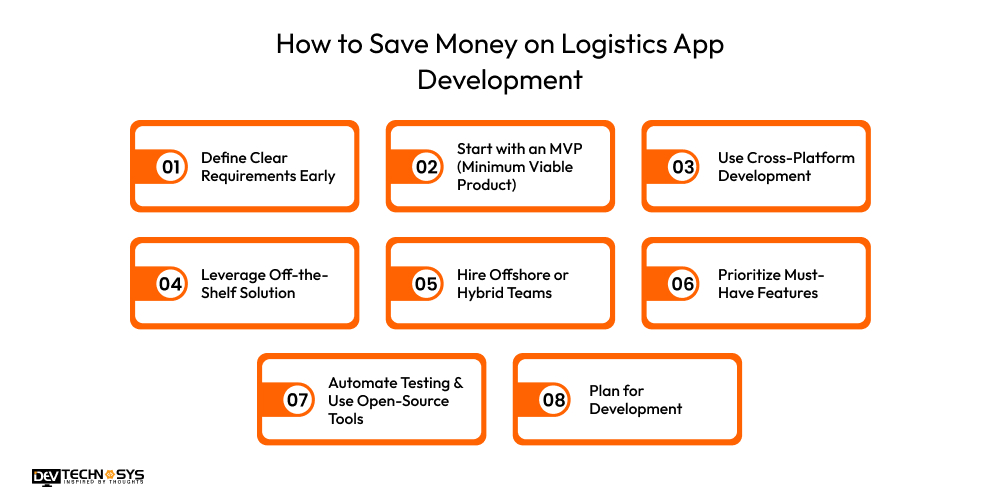
-
Define Clear Requirements Early
Avoid scope creep by clearly defining your goals, features, and technical needs from the outset. The more precise your plan, the less time and money you will spend on revisions.
Development providers should also state the mobile transportation software development charges clearly beforehand.
-
Start with an MVP (Minimum Viable Product)
It is better to start with MVP app development. Focus on essential features first, such as route tracking, shipment status, and notifications.
You can scale later based on user feedback. Stating your requirements clearly from the start can help businesses save on cost to create a transportation management system.
-
Use Cross-Platform Development
According to developers who provide transportation software development services in Qatar, tools like Flutter or React Native let you build for both Android and iOS using a single codebase, reducing the time and cost to make logistics and transportation app.
-
Leverage Off-the-Shelf Solution:
The cost to launch a logistics and transportation app can be reduced by leveraging third-party solutions. Use pre-built APIs or modules for maps, geolocation, chat, and payment instead of building everything from scratch.
-
Hire Offshore or Hybrid Teams
One way to save money on logistics apps is by hiring offshore development teams that offer top-notch transportation software development services in Qatar.
Development rates vary globally, so working with experienced teams from regions such as Eastern Europe or India can significantly reduce costs.
-
Prioritize Must-Have Features
Don’t overpack the app in the first version. Focus on features that solve core logistics problems, like delivery tracking or order management.
-
Automate Testing & Use Open-Source Tools
The transportation software development pricing can be reduced by using automation tools. These automation tools are used for QA and considering open-source libraries for backend, analytics, and UI elements to save time and licensing fees.
-
Plan for Development:
For the development phase, split the project into stages: build, test, release, and improve, allowing you to manage your transportation software development budget and refine it as you grow.
Conclusion
In 2025, the cost of developing transportation software can vary based on factors like the project’s complexity, feature set, and development approach. Whether you want a basic tracking system with essential features or an advanced logistics platform, careful planning, smart tech choices, and phased development can help you stay within budget.
If you are a business looking for a reliable mobile app development company for your transportation app development, then contact Dev Technosys, a leading name in the transportation app development industry. Our experts possess decades of expertise and experience in developing logistics apps. Stay tuned for more informative updates.
FAQs
1. What Is The Minimum Cost To Build Transportation Software In 2025?
The minimum cost of developing a transportation software starts around $8,000 for a basic tracking or logistics system with limited features.
2. What Features Can Affect The Cost The Most?
Features affecting the transportation software development cost include real-time GPS tracking, route optimization, multi-user roles, AI-powered dispatching, and third-party integrations significantly impact the cost.
3. Is It Cheaper To Build A Cross-Platform App Than Native Apps?
Yes. Cross-platform development (like Flutter) is usually more cost-effective and faster than building separate iOS and Android apps.
4. How Long Does It Take To Develop Transportation Software?
The development timeline ranges from 1.5 to 5 months depending on the app’s complexity and the size of the development team.
5. Can I Start With A Basic Version And Scale Later?
Absolutely. Many businesses start with a Minimum Viable Product (MVP) and gradually scale features based on user feedback and business needs.



